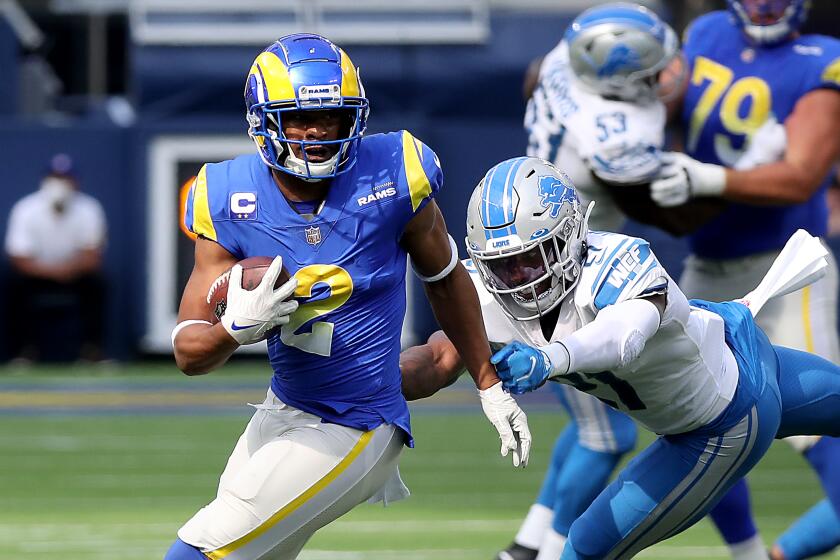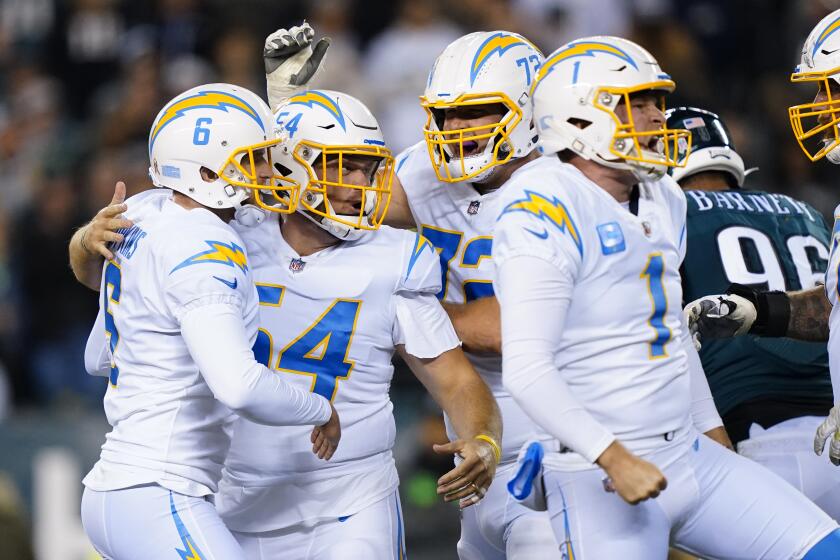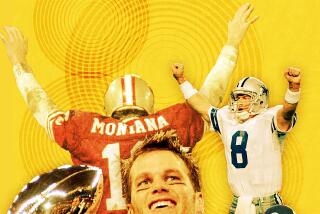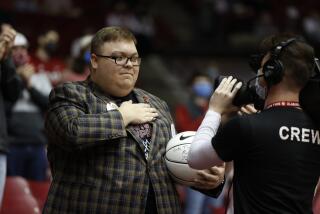Hard-hitting Hall of Fame linebacker Sam Huff dies at 87

- Share via
Sam Huff, the hard-hitting Hall of Fame linebacker who helped the New York Giants reach six NFL title games from the mid-1950s to the early 1960s and later became a popular player and announcer in Washington, died Saturday. He was 87.
Huff family lawyer Deborah Matthews told the Associated Press that Huff died of natural causes in Winchester, Va.
Huff always will be remembered as the furious middle linebacker in a 4-3 scheme developed for him by fellow Hall of Famer Tom Landry, his defensive coordinator with New York and later the architect of the Dallas Cowboys’ rise to power.
Raised in West Virginia coal mining country, Huff became a two-time All-Pro in a career that spanned from 1956 to 1969. His major regret was winning only one of the title games in which he played, the championship in his rookie season when the Giants crushed the Chicago Bears 47-7 at Yankee Stadium.
Huff was selected as the NFL’s top linebacker in 1959. He went to five Pro Bowls, four with the Giants and one with Washington, playing in an era when he regularly crashed into the likes of Jim Brown, Jim Taylor and other bruising running backs.
“Anyone who knew Sam knew what an amazing person he was,” Washington owners Dan and Tanya Snyder said. “He was an iconic player and broadcaster for the franchise for over 40 years and was a great friend to our family. He represented the franchise with honor and respect on the field in the booth and was beloved by our fans.”
Odell Beckham Jr. says he and Robert Woods were excited about the possibility of playing together on the Rams before a torn ACL ended Woods’ season.
The baby-faced Huff became the first NFL player featured on the cover of Time magazine, appearing on Nov. 30, 1959.
“The Twentieth Century,” a documentary television program hosted by Walter Cronkite on CBS that began in the late 1950s, once broadcast a piece on him titled “The Violent World of Sam Huff.” Huff wore a microphone during practice and an exhibition game for the piece.
Drafted out of West Virginia in the third round in 1956, Huff played for New York from 1956 to 1963. He was traded to Washington before the 1964 season and played there for the next four seasons. He retired after the 1967 season, sat out the next year and returned for a final season in 1969 as a player-coach under Vince Lombardi.
When Huff was inducted into the Pro Football Hall of Fame in 1982, he said football players can’t be discouraged and will not quit, even if beaten in a game. He believed in fair and hard play.
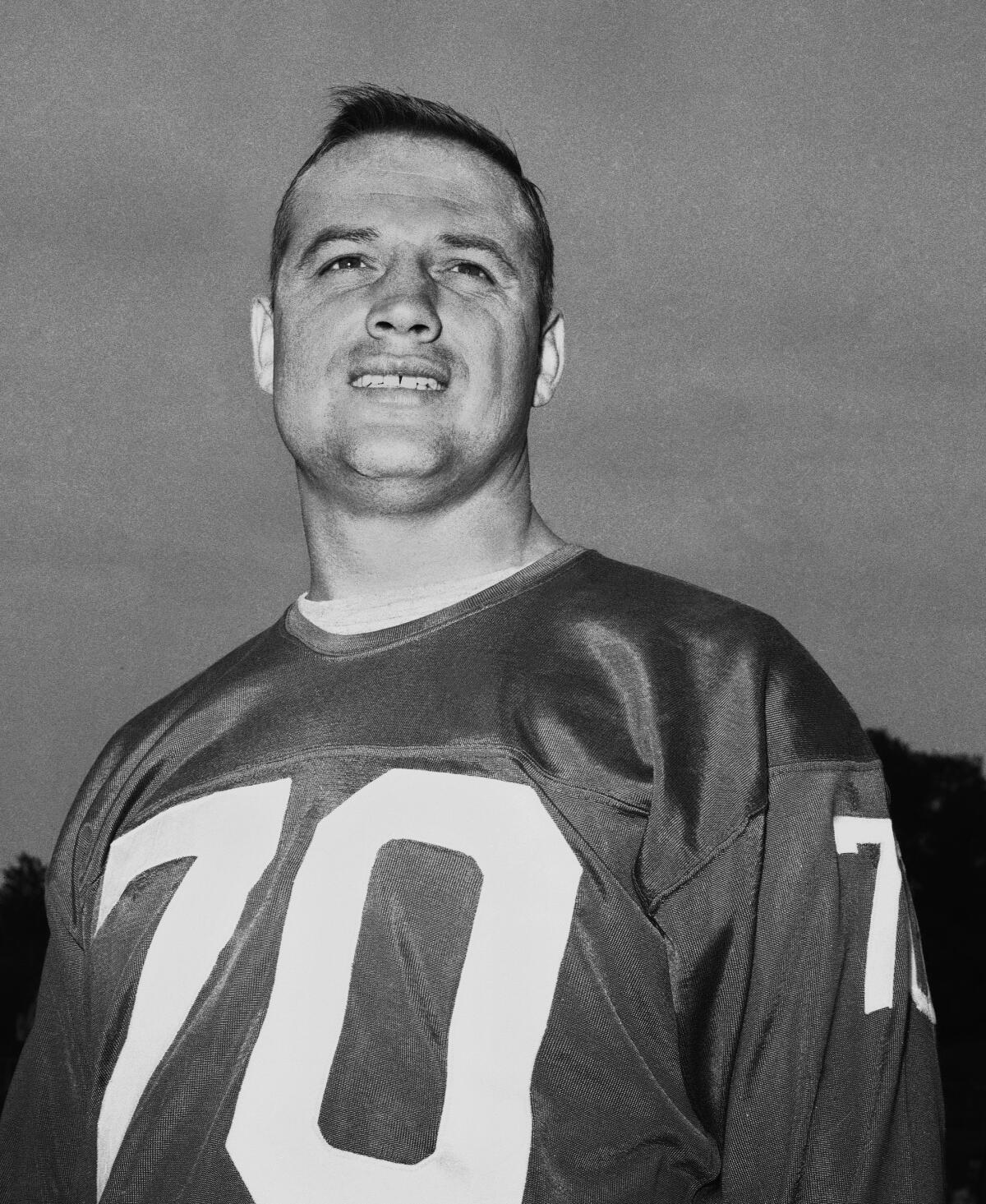
“He may not be an All-American, but he is an example of the American way,” Huff said in his induction speech. “He is judged not for his race, nor for his social standing, or not for his finances, but by the democratic yardstick of how well he blocks, tackles and sacrifices individual glory for the overall success of his team.”
After his playing career ended, Huff found another behind the microphone.
Huff spent three seasons working as a color commentator for the Giants on radio before moving over to a similar job with Washington, where he spent 38 years calling games, starting in 1975.
From 1981 to 2012, his longtime broadcasting partner was a former Washington teammate, quarterback Sonny Jurgensen. They called all three of Washington’s Super Bowl titles.
The Chargers might have two more wins than the Minnesota Vikings but these teams are evenly matched and both have been experiencing nail-biters all season.
Huff was an every-down linebacker. He had the determination and strength to take on power running backs of that time and had the speed to cover backs on pass routes. He had 30 interceptions, 17 fumble recoveries and five touchdowns.
Coming out of college, Huff didn’t have an easy transition to the NFL. The Giants used him initially as an offensive lineman tackle — hence the No. 70 that he always wore.
Huff didn’t feel comfortable there and shorty after training camp opened in 1956, he got fed up and left. Lombardi, then a Giants assistant coach, caught him on the way to the airport and convinced him to come back, suggesting it would be better than the coal mines of West Virginia.
Landry eventually developed a 4-3 defense, which was a better fit for the mobile Huff, and he was switched to middle linebacker behind Ray Beck. Landry used to have the rookie come to his apartment in New York, and they would spent nights discussing defenses.
Huff learned and developed an ability to read plays and disrupt them. When Beck was hurt on Oct. 7, 1956, Huff took over and the rest became part of his Hall of Fame story.
Robert Lee “Sam” Huff was born in a mining camp in Edna, W. Va., on Oct. 4, 1934. His father and two of his brothers worked in the coal mines, and he lived in a small rowhouse with no running water.
Huff was a two-way lineman in high school and went to West Virginia, where he played guard as a sophomore and tackle in his final two years.
After retiring as a player, Huff coached for a year with Washington in 1970. He soon took a job in marketing with Marriott and worked until 1998.
Associated Press sportswriter Stephen Whyno contributed to this report.
More to Read
Go beyond the scoreboard
Get the latest on L.A.'s teams in the daily Sports Report newsletter.
You may occasionally receive promotional content from the Los Angeles Times.
